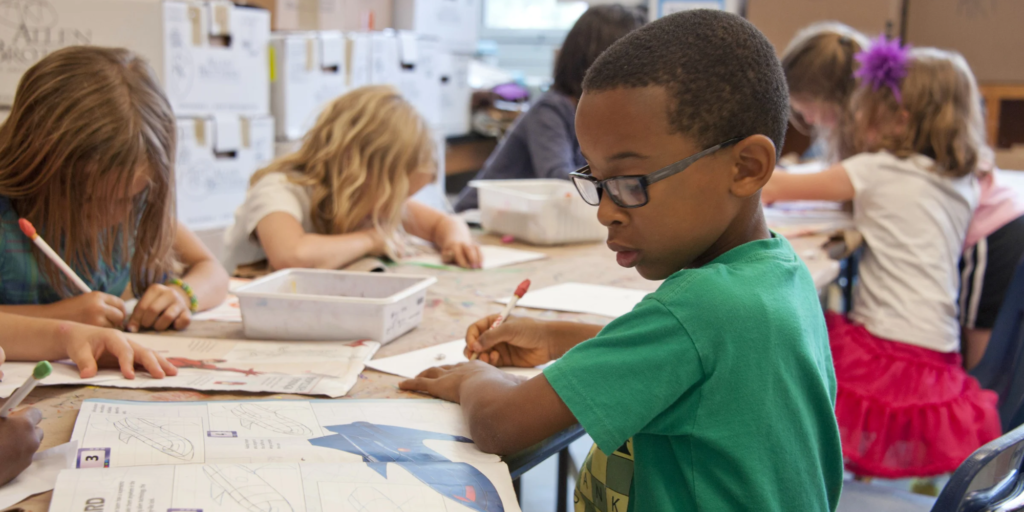By Brit Seward, M.Ed., School Improvement Representative, Math Specialist
As a Black mother raising a Black boy, conversations with other parents and educators about Black youth are common. In a recent conversation, a friend of mine shared the story of DeMarcus, a second-grade classmate of her son. When the two boys started carpooling together for baseball, my friend admitted she had unfairly judged Demarcus based on what her son had told her. Her son had said he was disruptive and was often kicked out of class. “He is bad,” her son would say. However, after several car talks and playdates my friend told me, “Demarcus is actually very intelligent.” Even my son has begun to speak differently about him: “When you get to know him, he’s funny and kind.” As I drove home after talking with my friend, my mind was troubled at the assumptions made and treatment of DeMarcus in and out of the classroom. You may be surprised to learn both the teacher and the mother are Black. I was frustrated at how common the story of Demarcus and similar narratives have become in classrooms today.
History forced the integration of schools where Black students were “integrated” into White schools that did not want them (Brown vs the Board of Education). Their new school environments were often hostile, combative, and unsupportive. What has changed? Data shows that when the teacher is White, the support for students of Color in the classroom is half that of White students (Id-Deen et. al., 2022). Eighty-five percent of students in the BCHF (Buckeye Community Hope Foundation) portfolio are students of Color – 63% are Black. This is an important statistic because nearly 80% of the teaching force is White (Toldson, 2019). Additionally, Civil Rights leader Bob Moses noted, “economic access and full citizenship depend crucially on mathematics and science literacy.” He believed the ability to do mathematics allows a person to work and fully participate in politics. What does this mean for Black students of mathematics in our schools?
It is necessary to recognize “Black boy joy,” “Black girl magic,” and Black brilliance in our Black students. We must not only be conscious of the environment we create for our Black students, but we must be intentional about the messages we communicate about Blackness. In the article, “From Green Book to Gradebook: Supporting Black Students’ Success in Math Class,” students share their experiences in mathematics class. One student shared, “I get so mad that I don’t want to learn from her. The minute my White teacher thinks I’m sassing her, then she will ask me to leave the classroom. Sometimes I just have bad days and I just want some space…I still want to learn.” Another student shared, “Everyone knows she calls on the White students more than the Black students. It’s like she doesn’t think we know the answers.” A classmate commented, “If we don’t know the answer, she calls on someone else. But if it’s a White student, she will ask the question in a different way.” How often have you been guilty of a similar practice?
More than twenty years after the NCTM (National Council of Teachers of Mathematics) released its Equity Principle calling for high expectations and strong support for all students (p.12), student experiences in mathematics show much work still needs to be done. In the previously mentioned article, “From Green Book to Gradebook, “identifies three needs of Black students to move toward equity in mathematics:
1. Black students need to belong
2. Black students need to be academically challenged
3. Black students need to have allies and advocates
As educators, it is our responsibility to acknowledge, reflect on, and dismantle the systemic roadblocks that do not help Black students. Acting on these three things requires an acknowledgement of our own implicit bias. Teachers’ perceptions of Black students’ behaviors have a negative impact on teachers’ intellectual expectations for those same students. Black students need to be challenged and have clear communication about strategies for success. Articulation of high expectations, without strong support and explicit direction, falls on deaf ears. Action also requires an acknowledgment that Blackness is more than skin color. It is a history and culture that is beautifully brilliant, full of genius, vibrancy, and creativity. It is thus unacceptable to say “I don’t see color” or “I treat all my students the same.” Seeing their Blackness is acknowledging all that makes Black students who they are. It is an act of honoring our students’ whole selves. Black students need to feel a sense of belonging and challenge. They must have allies and advocates in their corner. Educators must consider the Demarcus’ of the world and decide they are not “bad” or troublesome. Indeed, educators must really see their Black students and their Blackness as they truly are, kind and brilliant.
“Do not be blinded by their Blackness. Black students are not as mature or tough as you may perceive their Black bodies to be. They are children who want to be seen and know they are safe.” (Id-Deen et al., 2022).

